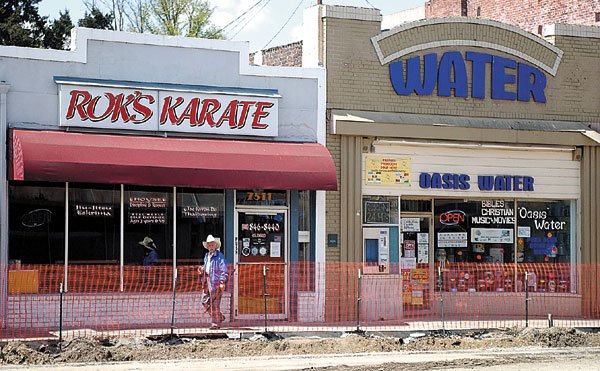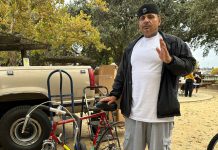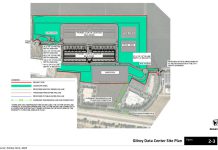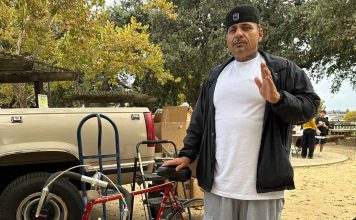The Dispatch turns back through the pages of history to 100
years ago, when the ground shook violently for nearly two
minutes
Gilroy – Nearly every chimney in town is down, and several of the fire walls are down. Plastering fell in the high school building and in many homes, and one or two of the churches. The heaviest loser is Mr. Thos. Rea, whose brick store buildings are all damaged and rendered unsafe. Dr. Clark’s operating room was a sorry plight, many valuable instruments being ruined. The hospital patients were moved to other quarters. The plate glass windows in McComas & Roth’s and Hecker’s were broken. The cornice and fire wall is off the north wall of the hospital and the post office building.
Here in Gilroy where the damage was light and no lives lost, we cannot conceive of the damage done and havoc wrought in San Jose, San Francisco and other coast towns. When everything denoted a prosperous year, San Francisco, the metropolis and pride of the West, has been almost wiped off the map by the unseen powers to which we bow our heads in abject fear.
On April 21, 1906, the lead story in the Gilroy Advocate was headlined ‘Awful Catastrophe!’
Three days earlier, a 7.9-magnitude earthquake rocked San Francisco and sparked a major fire, sending refugees throughout the Bay Area. Gilroy was among the cities that were largely spared, with a final estimate of $20,000 – or $400,000 in today’s dollars – in property damage. Though the catalogue of destruction paled in comparison to San Francisco and other cities, many Gilroyans remained anxious to hear word from friends and relatives.
Fred W. Blake and Will F. Blake, the publisher and editor of the Advocate (according to an account later in the century), spent the latter half of April 1906 reporting their personal observations and the tales of refugees.
“Oh! the terrible suspense of it all!” they wrote three days after the quake. “No wonder that business and schools are suspended, and the depot is thronged with anxious relatives and friends. Yet the hope that burns in every breast leads all to look on the brighter side and pray for their safety, although each succeeding hour makes the nerve tension greater.”
The following week the paper reported mostly good news for residents.
The front page featured an inspection report on the city’s downtown buildings – most of them declared safe – and a long list of Gilroyans who escaped the San Francisco disaster.
Henry Miller, the Cattle King, and his son and daughter in-law escaped from “their Essex Street mansion to see it burned to the ground. They took refuge with Mrs. Nellie Nickel at Menlo Park, and are now at the Bloomfield Farm.”
In an era before quotations became a staple of newspaper reporting, the Advocate recounted the “thrilling escape” of John Radin, the nephew of George Milias, from the San Francisco fire that followed on the heels of the quake.
“He was in the top floor of a four-story lodging house when it collapsed,” the Advocate reported. “Shortly after fire broke out, and he was almost suffocated with smoke and gas, and was bruised and scratched by falling debris. He was one of the few to escape from the Brunswick, the majority being roasted in the burning building. He is thankful to be alive.”
The paper informed residents that Mayor George Dunlap had created a Gilroy Relief Committee to aid refugees of the disaster and to coordinate the city’s recovery efforts. In a separate proclamation, he called on businesses to avoid price gouging and for residents to act charitably toward those fleeing from surrounding areas.
The disaster also served as occasion for some pre-election name clearing by a prominent citizen, George Milias, who had been accused of over-charging two boys for bread and butter in the days after the earthquake.
“If a Gilroy citizen who reported that I have taken advantage of unfortunate people in charging them 25 and 50 cents for a loaf of bread told this as it was repeated to me, he is a liar and no gentleman,” Milias wrote, going on to say he contributed more to charity than any 25 businesses in town.
On the same page, Dunlap followed his appeal to Gilroyans’ charitable instincts with a less than subtle threat to detractors of the city’s disaster response.
“The desolation and distress which now confronts our neighbors and friends, and which we may materially aid in lessening, is so paramount to these invented issues,” he wrote in his proclamation, “that further persistence in the way of newspaper abuse may become intolerable, and if not voluntarily abated, lead to measures for its suppression none will remember with pleasure.”
Dunlap won re-election on May 7 with more than a third of Gilroy’s 600 registered voters, many of whom were carted to the polls by the city administration. Milias secured a berth on city council with 345 votes – the most of any candidate. He had the support of “both the saloon and anti-saloon parties, although he is a saloon man,” the Advocate reported.
By the time election results rolled in May 12, earthquake coverage had faded from the broadsheet. In comings days, it reported on $300 in reconstruction assistance from New Jersey and the continuing work of the relief committee.
From the start, the paper expressed the sentiment that Gilroy was spared the worst of the ’06 tragedy. In its wake, the real struggle would take place to the north.
“Relief trains and boats laden with provisions and supplies are hurrying to San Francisco from Los Angeles, Sacramento and Stockton,” the Advocate reported on April 21, 1906. “Congress has appropriated $1,000,000, Rockefeller has given $100,000 and every city in the country is raising subscriptions for San Francisco, the city that has always been foremost in sending succor to every stricken city or country in the world. Dear old Frisco will soon rise again, Phoenix-like from her ashes, a grander, more beautiful city , and show the world what western energy and enterprise may accomplish.”














